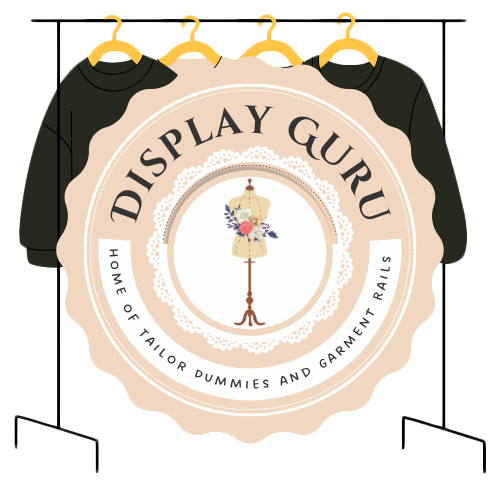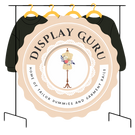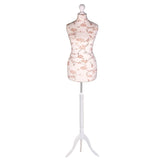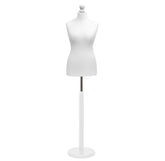Choosing Your Perfect Lockable Glass Cabinet
A lockable glass cabinet strikes the perfect balance between security and style. It's designed to keep your valuable items safe while still showing them off in all their glory. Think of it as your own personal gallery, letting you display merchandise or collectibles with complete peace of mind, all thanks to its see-through panels and a sturdy lock.
Marrying Security with Style in Display
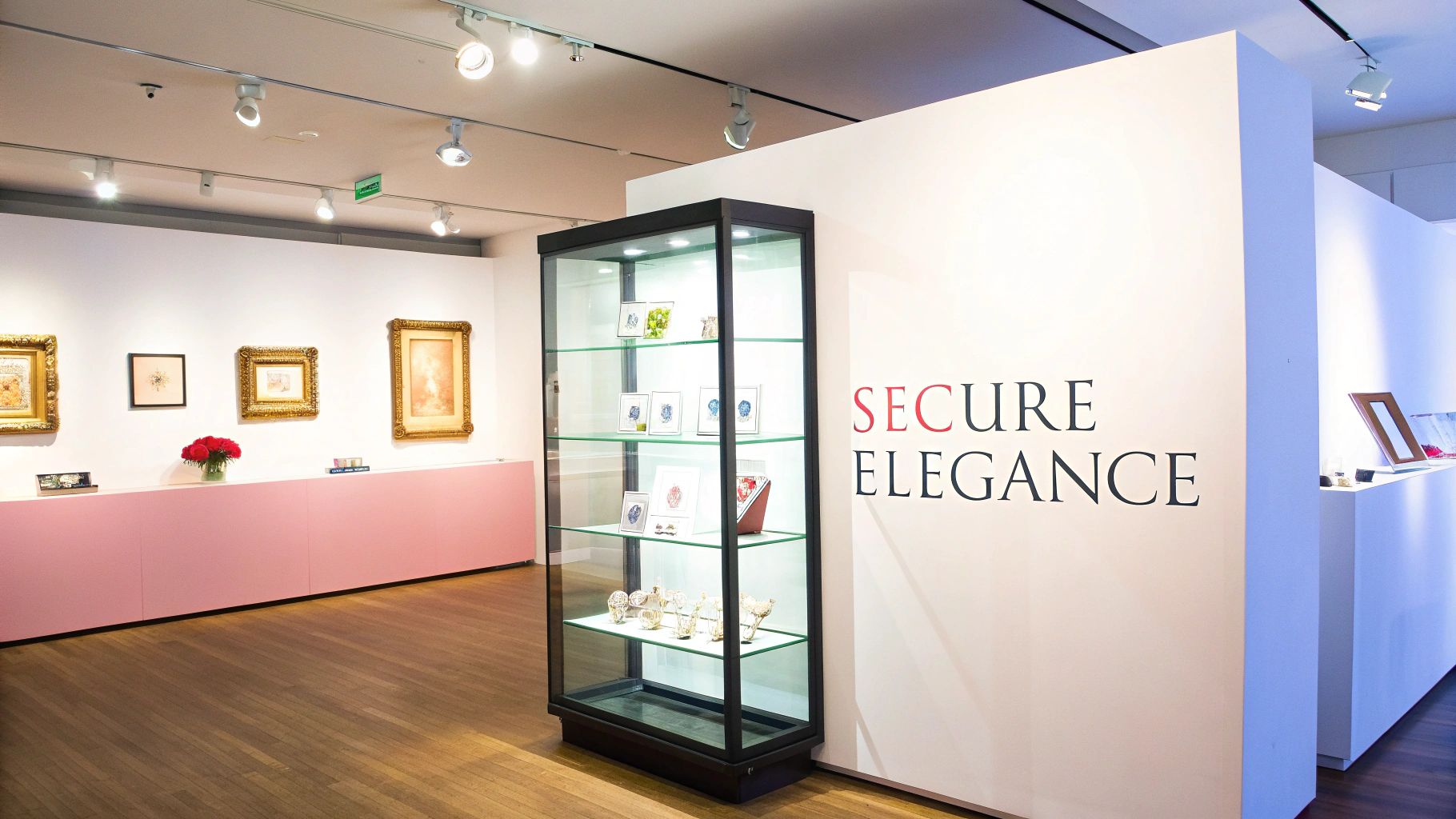
This isn't just another piece of furniture; a lockable glass cabinet is a clever presentation tool. It elegantly solves a common problem for retailers, designers, and collectors: how do you make your items look inviting while protecting them from theft, dust, and damage? It’s basically a secure stage for your most prized possessions.
This idea of 'secure elegance' is what makes them so valuable. The glass draws people in, encouraging them to admire a bespoke suit in a tailor's studio, a collection of rare vinyl at home, or high-value electronics in a shop. The lock then creates a clear but polite boundary, signalling that the contents are valuable and handling is restricted. This double act actually makes the items inside seem more exclusive and desirable.
Why Choosing the Right Cabinet Matters
Picking the right cabinet is a big deal. It affects everything from the look of your space to the safety of your items. The perfect cabinet will blend right in with your décor, make your displayed items pop, and give you the security you need. Get it wrong, and you could end up with something that clashes with your room or, worse, doesn't offer enough protection.
You need to think about what you're using it for:
- For Creative Professionals: If you're a tailor, costume designer, or merchandiser, you need a cabinet that doesn't just protect your work but shows it off properly. Look for features like built-in lighting and adjustable shelves – they’re essential for telling a compelling visual story.
- For Retailers: In a shop, a display cabinet works like a silent salesperson. The quality of the glass, the sturdiness of the lock, and the overall design all shape the customer's experience and can nudge them towards a purchase. For more on this, check out our guide on effective display cabinets for shops.
- For Collectors and Hobbyists: For a collector, nothing is more important than protecting a beloved collection. You need to be confident that your cabinet will guard against everything from dust to sticky fingers, preserving the value and condition of your items for years to come.
At the end of the day, a lockable glass cabinet is more than just a box. It's an investment in how you present and preserve the things that matter most. It creates a controlled space where beauty can be safely admired.
This guide is here to walk you through everything you need to know. We'll delve into materials, lock types, and placement tips to help you find that perfect sweet spot between fantastic visibility and robust security for your professional or personal needs.
Understanding Cabinet Construction and Materials
The strength and style of a lockable glass cabinet really come down to the quality of its parts. To pick a unit that's both secure and looks fantastic, you need to understand the core materials: the glass, the frame, and the internal features. It’s a bit like judging a well-made suit – you have to look past the first impression and get a feel for the fabric, the quality of the stitching, and the structure holding it all together.
The Two Faces of Safety Glass
When it comes to the glass itself, it’s certainly not all the same. For secure displays, your main choices are tempered glass and laminated glass, and each offers a different kind of protection. Think of them as two different types of bodyguards for your valuables.
Tempered glass is heat-treated, making it up to four times stronger than ordinary glass. Its real party trick, though, is what happens when it breaks. Like a car's side window, it shatters into thousands of tiny, blunt pebbles instead of dangerous jagged shards. This makes it a brilliant choice for busy shops or homes with kids running about, as it massively reduces the risk of injury.
Laminated glass works on a different principle. It’s made of two or more sheets of glass fused together with a plastic interlayer. If it gets hit hard enough to break, the glass cracks but the pieces stay stuck to that inner layer, much like a car's windscreen. This offers a much higher level of security against a break-in, because the pane remains a barrier even when it's damaged.
A key development in glass quality actually has its roots right here in the UK. The float glass process, pioneered by Pilkington Brothers Ltd back in the 1950s, was a game-changer. It allowed for the creation of the large, flawless sheets of glass that are the foundation of modern cabinet panels. By the late 20th century, data showed that over 60% of display glass in UK furniture had advanced safety treatments to meet new regulations.
Choosing Your Cabinet Frame Material
The frame is the skeleton of your glass cabinet. It provides the structural support and really defines the overall look. The material you go for will affect its weight, how long it lasts, and its style.
- Aluminium: This is a great modern choice. It’s lightweight, won't rust, and gives a sleek, minimalist look. Aluminium frames are perfect for contemporary spaces and are easy to shift around, but they can be more prone to dents than steel.
- Steel: If you need maximum strength and security, steel is the one. It's much heavier and incredibly tough, making it the ideal choice for protecting very high-value items. Powder-coated steel also stands up brilliantly to scratches and chips.
- Wood: For a classic, warm feel, nothing beats a wooden frame. It brings a traditional elegance to a room. Hardwoods like oak or maple are very durable, but they are heavy and might need a bit more care over the years to keep the finish looking its best.
Choosing your frame is all about balancing your security needs with the look you want for your space. For a deeper dive, our article on choosing your display cabinet with glass has some extra pointers.
Essential Features That Complete the Picture
Beyond the glass and frame, it’s the smaller details that often make the biggest difference. These are the features that separate a basic cabinet from a truly professional display unit.
Shelving and Stability
The shelves have a tough job. They need to be strong enough to hold your items without sagging over time. Tempered glass shelves are a popular option because they let light shine through the whole cabinet, lighting everything up beautifully. Always check the maximum weight capacity for each shelf before you buy. The base is just as critical; a solid, wide base or the option to bolt the unit to a wall is a key safety feature to stop it from tipping over.
Integrated Lighting
The right lighting can turn a simple display into a real showstopper. These days, LED lighting is the industry standard, and for good reason.
- Energy Efficient: LEDs use a fraction of the power of old-fashioned halogen bulbs, which keeps your electricity bills down.
- Low Heat Emission: They give off very little heat. This is absolutely vital for protecting delicate things like fabrics, old documents, or collectibles from long-term damage.
- Excellent Colour Rendition: Modern LEDs are fantastic at showing the true colours of your items, making them look exactly as they should.
By thinking carefully about these core elements—glass, frame, and practical features—you’ll have a much clearer idea of what makes a lockable glass cabinet a truly great investment.
Selecting The Right Lock For Maximum Security
https://www.youtube.com/embed/aYixW3YossI
If you think of the cabinet frame as the skeleton, the lock is without a doubt its heart. The entire security of your display hinges on this one small mechanism, so getting it right is crucial. Choosing the best one comes down to matching the lock's strength to the value of what's inside, ensuring your display is genuinely secure, not just stylish.
It's a bit like choosing a lock for your front door. You wouldn't use a simple bathroom latch to protect your home, would you? By the same token, you shouldn't rely on a basic lock for irreplaceable items or high-value merchandise. The trick is to understand what’s available and what level of protection each type really offers.
Common Lock Mechanisms Explained
For most glass cabinets, you'll come across a few standard mechanical options. They all work on pretty simple principles but provide very different levels of security.
-
Cam Locks: These are by far the most common type you'll see. Turning the key rotates a small arm (the cam) behind the door frame, which blocks it from opening. They're straightforward, reliable, and cost-effective, which makes them perfect for general use, like securing craft supplies or less valuable retail stock.
-
Plunger Locks: You often find these on sliding glass doors. When you push the lock's cylinder in, a bolt ‘plunges’ into a hole in the other door or the frame, locking it in place. They’re usually keyed and offer a definite step up in security from a basic cam lock, making them a good fit for things like electronics or designer accessories.
-
Ratchet Locks: Working in a similar way to plunger locks, a ratchet lock uses a toothed bar that slides across to lock sliding doors. It gives you multiple locking positions, which can be handy, but the security level is pretty much on par with a plunger lock.
To help you visualise how to balance features with your needs, this decision flowchart breaks down the choices based on the value and style of your items.
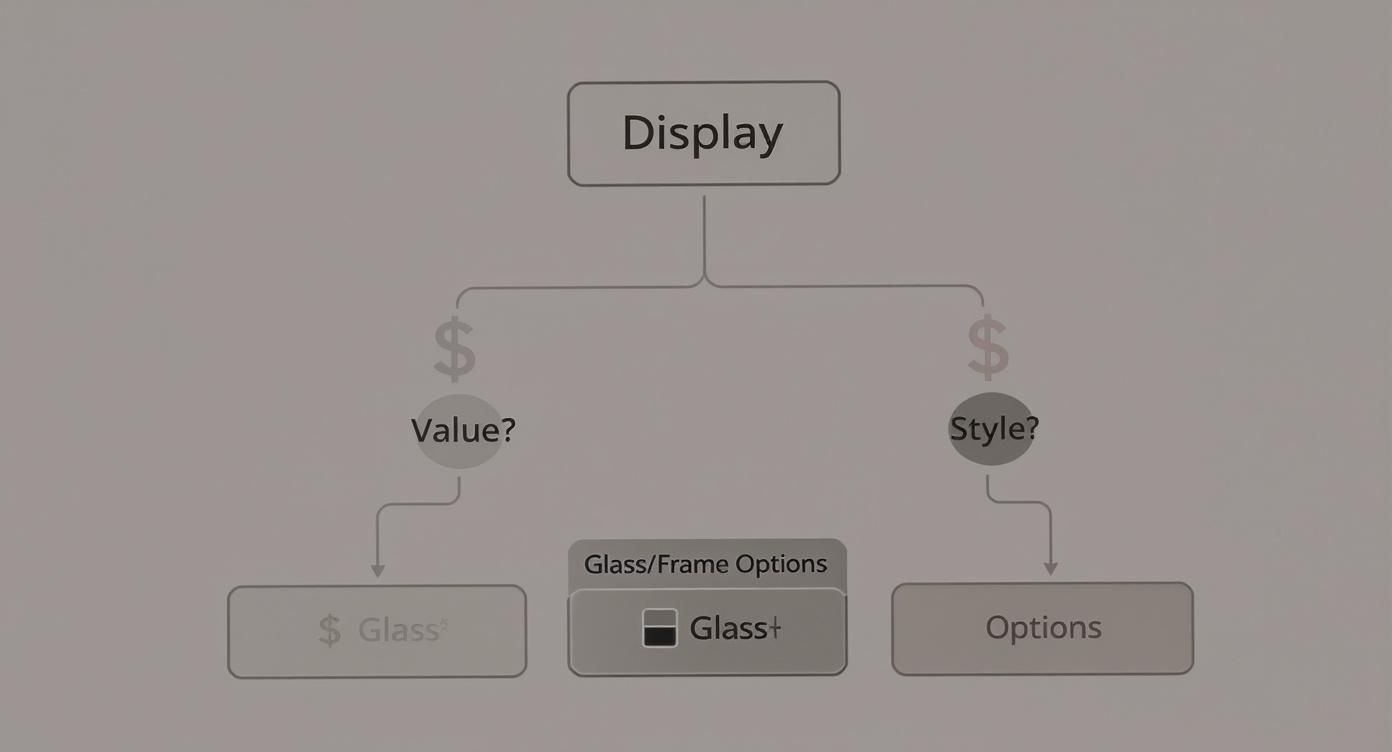
This guide shows how what you're displaying directly influences the best choice of glass and frame, blending both security and aesthetics.
Advanced Security For High-Value Items
When you're protecting fine jewellery, rare collectibles, or one-of-a-kind garments, a standard mechanical lock probably won't cut it. This is where more advanced systems step in to give you the robust protection you really need.
Electronic and digital locks are becoming much more common, and for good reason. These systems swap a traditional key for a keypad, meaning you just need a numerical code to get in. This instantly gets rid of the risk of lost or copied keys and lets you change the code whenever you need to—a massive plus in a shop with changing staff.
Keyless entry systems remove the weakest link in many security setups: the physical key. By using codes, cards, or even biometrics, they provide a higher level of control and auditability over who accesses your valuable items and when.
For the absolute highest level of protection, magnetic locks (or maglocks) are a powerful choice. They use an electromagnet to hold the door shut with incredible force—often needing hundreds of pounds of pressure to break. The initial investment is higher, of course, but for exceptionally valuable collections, the peace of mind is priceless. Many of the concepts behind these are shared with modern apartment smart lock systems, which also focus on integrated electronic access control.
To help you compare the most common options at a glance, we've put together this quick reference table.
Comparing Lock Mechanisms for Glass Cabinets
| Lock Type | Security Level | Typical Use Case | Pros | Cons |
|---|---|---|---|---|
| Cam Lock | Low | General retail, hobby supplies, personal collections | Inexpensive, easy to install, simple to use | Easily picked, not suitable for high-value items |
| Plunger/Ratchet Lock | Medium | Jewellery counters, electronics, designer accessories | More secure than cam locks, designed for sliding doors | Can be forced, key control is still a factor |
| Electronic/Digital Lock | High | High-end retail, controlled access environments | Keyless entry, easy to change codes, audit trails | Higher cost, requires power (batteries/wired) |
| Magnetic Lock (Maglock) | Very High | Museums, luxury boutiques, secure archives | Extremely high holding force, fail-safe options | Most expensive, requires professional installation |
Each lock has its place, and the right choice simply depends on balancing the value of your items against your budget and operational needs.
Key Management In a Professional Setting
For any business with more than one or two lockable cabinets, managing all those keys can quickly turn into a logistical nightmare. A messy system doesn't just waste time; it creates some serious security holes. That’s why a clear key management protocol is an absolute must.
A great starting point is assigning specific keys to trusted team members and using a logged sign-out/sign-in system. For larger operations, it's worth considering a master key system, where one key opens all cabinets, while individual keys are restricted to specific ones. This kind of layered approach is a cornerstone of solid asset protection. For more strategies like this, have a look at our guide on the best practices for inventory management.
Strategic Placement in Professional Spaces
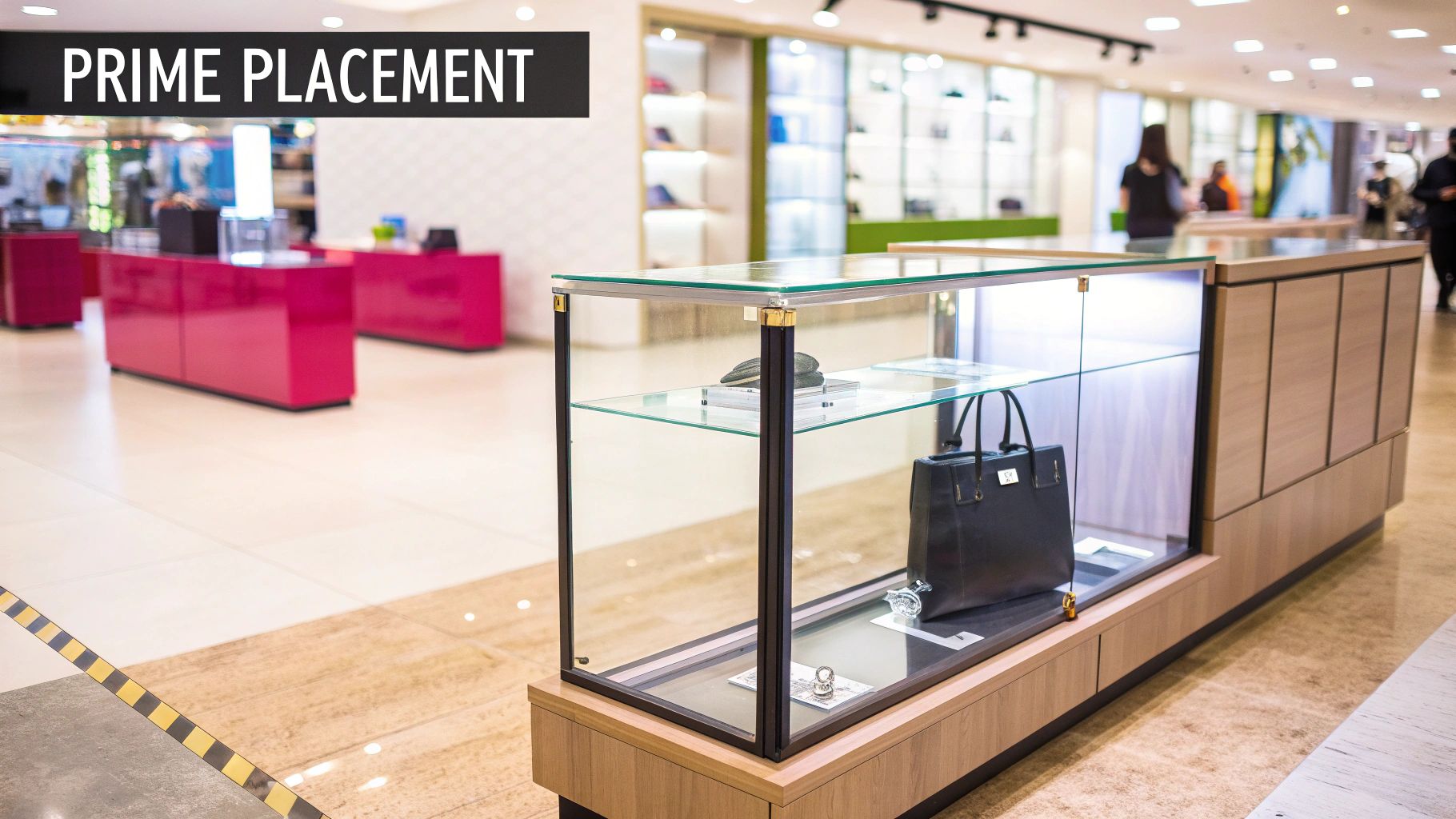
Owning a quality lockable glass cabinet is one thing, but knowing where to put it is where the real magic happens. The right placement can completely transform how customers interact with your products, shape the atmosphere of your space, and even add a subtle layer of security. It’s what turns the cabinet from a simple box into a profitable business asset.
Think of your professional space—whether it’s a retail shop, a design studio, or a gallery—as a stage. Your glass cabinet is the spotlight, drawing all eyes to your star attractions. Placing it correctly ensures it captures attention the moment someone walks in, guiding their journey and highlighting exactly what you want them to see.
Mastering Sightlines and Traffic Flow
The first rule of thumb is to understand how people naturally move through your space. Where do their eyes land first? What path do they instinctively take? By placing your cabinet along these high-traffic routes or at key decision-making points, you guarantee it gets seen.
A classic and effective strategy is to create a "feature display" just inside the entrance or at the end of a main aisle. This immediately showcases your most valuable or enticing items, setting a premium tone for the entire experience. To really get this right, you can explore our detailed visual merchandising guidelines.
This isn't just a hunch; it's a growing trend. The European display cabinet market—part of a global industry valued at around $5 billion as of 2025—is seeing a surge in demand for customised units with integrated lighting and better security. This growth reflects how much businesses are investing in creating compelling physical displays, a smart move in a world leaning on digital retail.
The Role of Lighting and Environment
Lighting, both ambient and direct, can make or break your display. A cabinet tucked away in a poorly lit corner will simply be ignored, no matter how stunning its contents.
- Natural Light: Position your cabinet to take advantage of natural light, but be careful to avoid direct, sustained sunlight. UV rays can cause delicate fabrics to fade or damage sensitive collectibles over time.
- Spotlighting: Use focused spotlights to highlight the cabinet in darker areas of your store or after hours. This creates a dramatic, high-contrast effect that makes the items inside feel even more valuable.
- Internal Lighting: Don't forget to use the cabinet's own built-in LEDs. Well-lit items don't just look better; they're also much easier for customers to inspect from a distance, making them more likely to take a closer look.
"Your display cabinet should never feel like an afterthought. It is an integral part of your room's architecture and flow. By placing it thoughtfully, you direct both movement and attention, turning a passive observer into an engaged customer."
As you think about where your cabinet will go, these essential furniture arrangement tips can be a great help in optimising the overall flow and feel of your room.
Installation for Safety and Stability
Proper installation is non-negotiable, especially in a professional space open to the public. An unstable cabinet isn't just a risk to your valuable stock; it's a serious safety hazard.
-
Find a Level Surface: Before you do anything else, check that the floor is perfectly level. Use a spirit level, and if you find a slope, use shims to correct it. An unbalanced cabinet puts unnecessary stress on the glass and frame.
-
Secure the Unit: For taller, freestanding cabinets, anchoring the unit to a wall is essential. This prevents it from tipping over. Most good-quality cabinets come with the right anti-tip hardware. This simple step is crucial for the safety of your staff and customers.
-
Check Clearances: Make sure there’s enough space around the cabinet for the doors to swing open fully without hitting anything. You'll also want to leave enough room for cleaning and for customers to stand back and admire the display without blocking a walkway.
By bringing these principles of placement and installation together, your lockable glass cabinet becomes far more than just secure storage—it becomes a powerful tool for presentation and persuasion.
Choosing the Right Cabinet for Your Craft
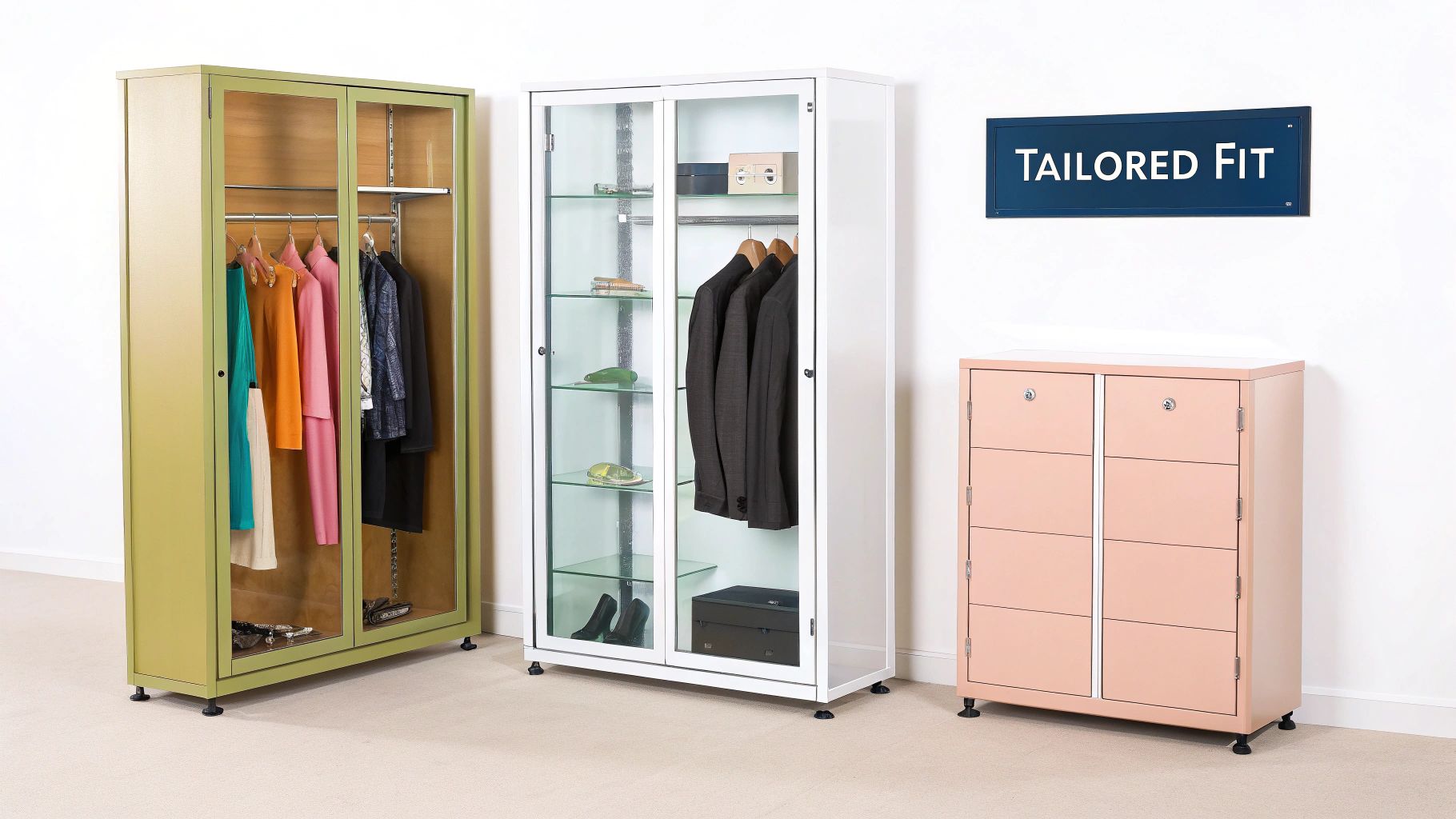
A great lockable glass cabinet is never a one-size-fits-all solution. Its real worth shines through when its features are perfectly matched to what you actually do. What works for a visual merchandiser setting up a slick retail display is worlds away from what a hobbyist needs to protect a cherished collection.
The trick is to think beyond simple storage. See the cabinet as a specialist tool that can elevate your craft or passion. When you connect the demands of your profession to specific features, you'll find a unit that doesn't just hold your items—it actively improves how you work with and present them. It’s all about finding that perfect synergy between design, function, and your unique goals.
For Tailors and Costume Designers
When you work with fabrics and garments, presentation is everything. A beautifully made suit or gown can lose all its magic if it's displayed in a way that creates wrinkles or hides the intricate details. That's why a tall, wardrobe-style glass cabinet is so often the right call.
The single most important feature here is an integrated hanging rail. It lets you display bespoke suits, elaborate costumes, or delicate dresses vertically, preserving their drape and keeping them completely crease-free. The full-length glass doors give an uninterrupted view, so clients can admire your craftsmanship without touching the garment itself.
A well-chosen cabinet is like a silent partner in your consultations. It showcases your work in the best possible light, shielding it from dust and accidental snags while letting the quality of the fabric and the precision of the cut do the talking.
Also, look for models with excellent internal lighting. Cool-toned LEDs are ideal as they show colours accurately, which is vital when you're assessing fabric textures and colour matches. A secure lock that’s still easy to open ensures your valuable, one-of-a-kind pieces are safe between fittings, giving you essential peace of mind in a busy studio.
For Visual Merchandisers and Retailers
In the fast-moving world of retail, your display cabinet is a powerful sales tool. Visual merchandisers need flexibility, visibility, and serious impact. A display that never changes quickly becomes part of the background, so the ability to create fresh, dynamic arrangements for new seasons or promotions is key.
This is where modular, brightly lit units really come into their own. You can reconfigure, stack, or rearrange them to suit different product launches or store layouts. Strong, adjustable shelving is non-negotiable, as it lets you showcase items of all sizes, from shoes and jewellery to electronics and cosmetics. Frameless designs are a popular choice because they maximise visibility and create a clean, modern look that puts the focus squarely on the merchandise.
For a display that truly sells, keep these features in mind:
- 360-Degree Viewing: A cabinet that can be viewed from all sides is perfect for a central spot on the shop floor, drawing customers in from every angle.
- Mirrored Backing: This simple addition can make a display feel bigger and more luxurious, bouncing light around and showing off products from multiple angles at once.
- High-Security Locks: In any retail environment, a robust lock is essential for preventing theft. A plunger or electronic lock is a smart investment.
If you’re working with a smaller pop-up or stall, checking out some different display ideas for craft fairs can spark some great inspiration for making a big impression in a small space.
For Collectors and Hobbyists
Whether you collect miniature figures, sports memorabilia, or rare antiques, your top priorities are preservation and security. A collector’s cabinet needs to be a fortress against the very things that can ruin valuable items over time: dust, sunlight, and clumsy hands.
The most critical feature is environmental control. Look for a cabinet with dust-proof seals around the doors. This creates a self-contained microclimate that drastically cuts down on cleaning and protects delicate surfaces. If your collection is anywhere near a window, UV-protective glass is also a very sensible upgrade to stop colours from fading over the years.
Of course, security is paramount, especially for high-value collections. A multi-point locking system, which secures the door at the top, middle, and bottom, is far tougher to breach than a standard single lock. This gives you confidence that your cherished items are safe not just from curious visitors but from a determined thief. Adjustable glass shelves are another great feature, letting you customise the interior to perfectly fit the scale of your prized possessions.
Essential Maintenance and Safety Tips
A lockable glass cabinet is more than just a piece of furniture; it's a long-term investment in how you present and protect your most valuable items. With a little care, it will keep your displays looking sharp and secure for years to come.
Think of it like looking after a classic car. A bit of regular attention stops small issues from becoming big problems later on. A few simple cleaning habits and mechanical checks will ensure your cabinet functions perfectly and always looks its professional best.
Keeping Your Cabinet Sparkling and Secure
Great cleaning comes down to using the right tools for the job and avoiding anything that could cause damage. You'd be surprised how easily harsh chemicals or abrasive cloths can create tiny scratches on glass or wear away the finish on the frame, making your whole display look tired.
For that perfect, streak-free shine on the glass, your best bet is a good quality, ammonia-free glass cleaner and two microfibre cloths. Instead of spraying directly onto the glass, which can lead to drips, spray the cleaner onto one cloth. Wipe the surface, then immediately follow up with the second, dry cloth to buff it. It’s a simple two-step trick that guarantees a crystal-clear, lint-free finish every time.
The frame needs a slightly different approach depending on the material:
- Metal Frames (Aluminium/Steel): A soft cloth with a bit of mild detergent and water is all you need.
- Wooden Frames: Stick to a cleaner made specifically for wood. This will feed the material rather than stripping its protective finish.
The Monthly Lock Check: Once a month, just give the lock a quick test. Does the key turn smoothly? Does it engage without a fight? A quick spray of a silicone-based lubricant into the keyhole once or twice a year is a great way to keep it working like new.
Putting Structural Safety First
Beyond keeping it clean, making sure your cabinet is safe is absolutely crucial, especially in a busy shop or a home with family around. An overloaded or unbalanced cabinet can be a real tipping risk.
Always make a point of spreading the weight evenly across each shelf. It's best to place heavier items towards the back and on the lower shelves. Be sure to check the manufacturer's weight limit for each shelf – pushing it too far can cause the glass to bend or, in the worst-case scenario, shatter. For any tall, freestanding cabinets, it is absolutely essential to anchor them to a wall with the anti-tip kit they come with.
If the worst happens and a glass panel cracks or breaks, safety has to be your first thought.
- Clear the Area: Get everyone, especially children and pets, away from the cabinet immediately.
- Wear Protection: Before you touch a single piece of broken glass, put on a pair of thick gloves and safety glasses.
- Careful Removal: Tempered glass will break into small, chunky pieces, which you can sweep up with a dustpan and brush. Laminated glass tends to hold together, so you might be able to remove the whole panel in one piece.
- Secure the Cabinet: Cover the opening to prevent access and keep the cabinet locked until you can get a professional to replace the glass.
Got Questions? We've Got Answers
Choosing the right cabinet often brings up a few practical questions. It's a significant purchase, so let's clear up some of the most common queries to help you make a decision you're happy with.
Just How Secure Are These Cabinets for High-Value Items?
This really comes down to the specific model you choose. For something truly valuable, like fine jewellery, antique artefacts, or irreplaceable collectables, a basic cabinet probably won't cut it.
You'll want to look for specific security features. Think toughened or laminated glass, a multi-point locking system, and a solid steel frame. Critically, the cabinet itself needs to be secured—always anchor it to a wall or the floor. An unbolted cabinet can just be carried away, lock and all. For a professional setup, think of it as one layer in your overall security plan, not the entire plan itself.
Can I Add or Change the Lighting Myself?
Absolutely. While many of our cabinets come with built-in LEDs, you might find a model without them or simply want to upgrade the existing setup. Aftermarket LED strip lighting kits are your best friend here. They're easy to find, generally self-adhesive, and you can run them along the inside of the frame or under the shelves for a professional look.
A word of advice: stick with low-heat LED versions. This is especially important if you're displaying delicate items like vintage fabrics, costumes, or important documents, as heat can cause damage over time. Always follow the manufacturer's instructions for a safe and tidy installation.
What’s the Secret to Getting Streak-Free Glass?
The key is to ditch the paper towels and harsh, ammonia-based cleaners. They're the biggest culprits behind those annoying streaks. Instead, the professional method uses two microfibre cloths.
- Take your first cloth and lightly spritz it with a good quality, ammonia-free glass cleaner. Never spray directly on the glass itself—it can drip into the frame and seals.
- Wipe down the glass to lift off all the dust and fingerprints.
- Before it dries, grab your second, completely dry microfibre cloth and buff the surface until it shines. This two-cloth trick is what removes every last bit of residue for that perfect, invisible finish.
At Display Guru, we provide the tools you need to present your work with style and security. Explore our extensive collection of professional display solutions by visiting us at https://www.displayguru.co.uk.
